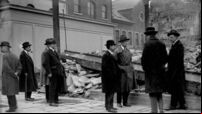Golden days of Cork childhood when we went slogging apples

Lacemaking at Glengarriff, Co. Cork, in June, 1956 - Throwback Thursday readers today recall the era when many people had craft skills
Can you those autumn and winter evenings of childhood, when you spent your time happily working on the latest bit of handicraft, the tricky bit of woodwork, the endless knitted scarf, even that model plane kit?










